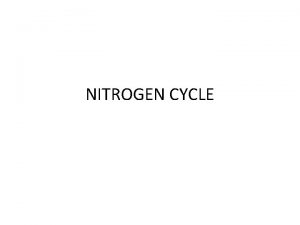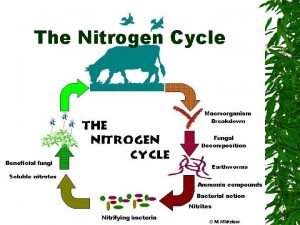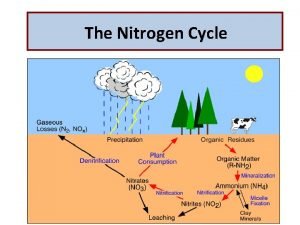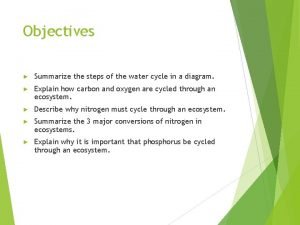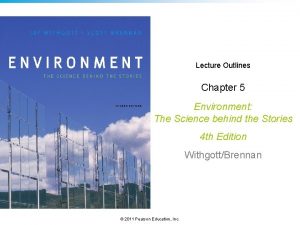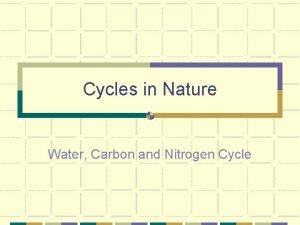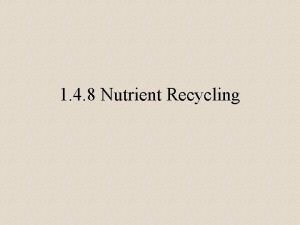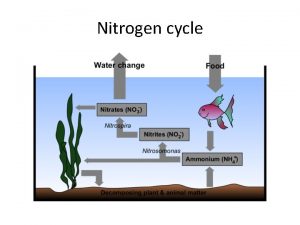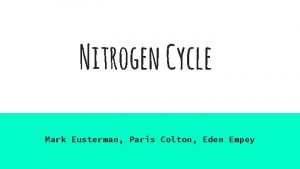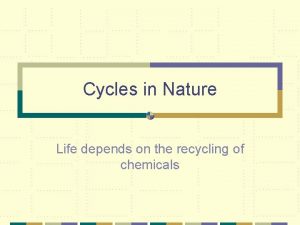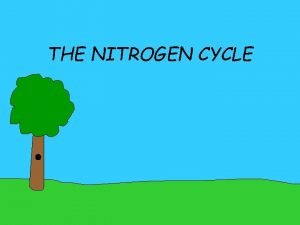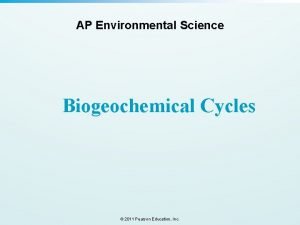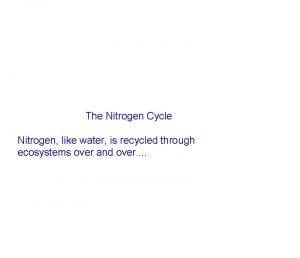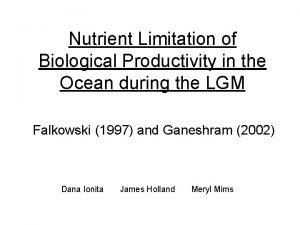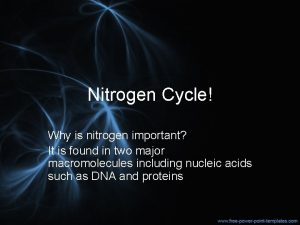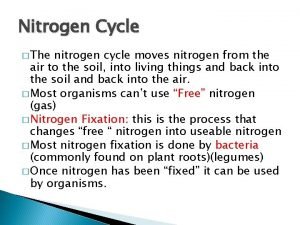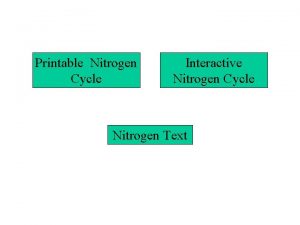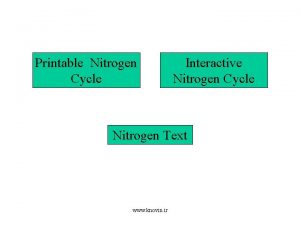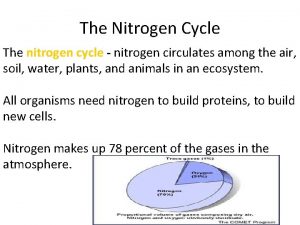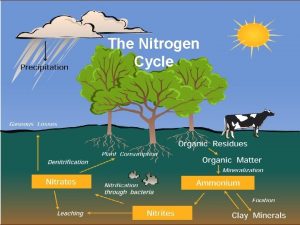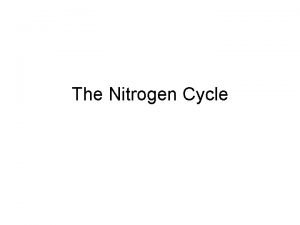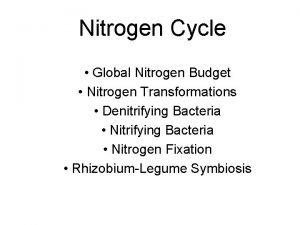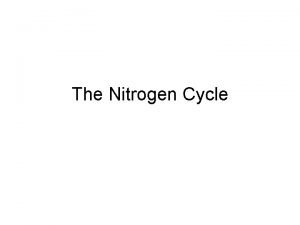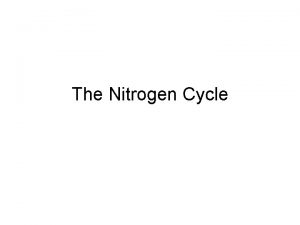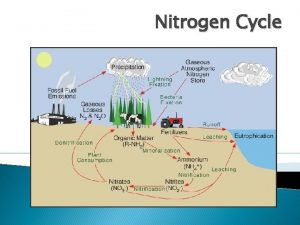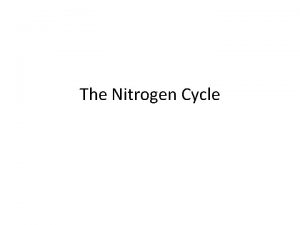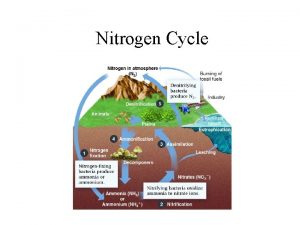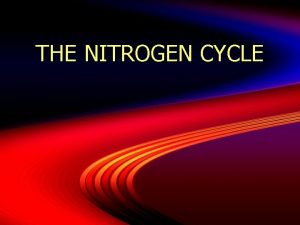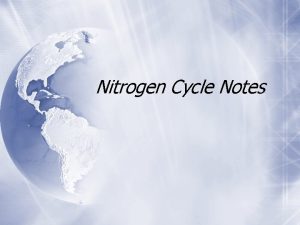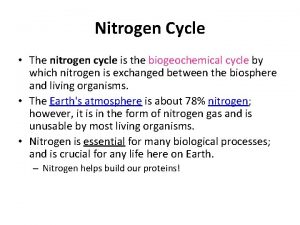The Nitrogen Cycle Where is nitrogen found in




























- Slides: 28

The Nitrogen Cycle

Where is nitrogen found in the environment?

The largest single source of nitrogen is in the atmosphere. Nitrogen makes up 78% of our air!

What happens to atmospheric nitrogen (N 2) in the nitrogen cycle? N N N

Atmospheric nitrogen is converted to ammonia or nitrates. N N Atmospheric Nitrogen (N 2) N N Ammonia (NH 3) Nitrates (NO 3) Nitrogen combines with Hydrogen to make Ammonia Nitrogen combines with Oxygen to make Nitrates

N N Why does atmospheric nitrogen need to be converted? N N

It is one of nature’s great ironies… Nitrogen is an essential component of DNA, RNA, and proteins—the building blocks of life. Although the majority of the air we breathe is nitrogen, most living organisms are unable to use nitrogen as it exists in the atmosphere!

How does atmospheric nitrogen get changed into a form that can be used by most living organisms? N N

By traveling through one of the four processes in the Nitrogen Cycle! (1) Nitrogen Fixation (4) Denitrification Nitrogen Cycle (3) Nitrification (2) Ammonification

The first process in the nitrogen cycle is… Nitrogen Fixation! (1) Nitrogen Fixation Nitrogen Cycle

“Nitrogen Fixation” is the process that causes the strong two -atom nitrogen molecules found in the atmosphere to break apart so they can combine with other atoms. Oxygen Hydrogen N N N Oxygen N Nitrogen gets “fixed” when it is combined with oxygen or hydrogen.

Most atmospheric nitrogen (N 2) is “fixed” and changed to ammonia (NH 3). Ammonia is highly toxic to many organisms. Can plants use ammonia?

Very few plants can use ammonia (NH 3)… (1) Nitrogen Fixation (2) Ammonification …but, fortunately the second process Ammonification can help!

What is ammonification?

Ammonification: Bacteria decomposers break down amino acids from dead animals and wastes into nitrogen ammonium. Bacteria decomposers break down amino acids into ammonium

Why is ammonification necessary?

Because plants cannot use the organic forms of nitrogen that are in the soil as a result of: (1) wastes (manure and sewage) (2) compost and decomposing roots and leaves

How does ammonification occur?

What happens to ammonium (NH 4) stored in the soil?

It travels through the third process of the nitrogen cycle called Nitrification! (1) Nitrogen Fixation (3) Nitrification (2) Ammonification

Nitrifying bacteria in the ground first combine ammonia with oxygen to form nitrites. Then another group of nitrifying bacteria convert nitrites to nitrates which green plants can absorb and use! Nitrifying bacteria in soil combine ammonia with oxygen Ammonia changes to nitrites Nitrifying bacteria in soil convert nitrites to nitrates Ammonia Nitrites Nitrates (NH 3) (NO 2) (NO 3) Plants absorb nitrates and grow!

How does nitrogen reenter the atmosphere in the nitrogen cycle?

Through the fourth process called denitrification! (4) Denitrification (3) Ammonification (1) Nitrogen Fixation (2) Nitrification

What does denitrification do?

Denitrification converts nitrates (NO 3) in the soil to atmospheric nitrogen (N 2) replenishing the atmosphere. Nitrogen in atmosphere (N 2) Nitrates (NO 3) in Soil

How does the denitrification process work? Nitrates in soil

Denitrifying bacteria live deep in soil and in aquatic sediments where conditions make it difficult for them to get oxygen. The denitrifying bacteria use nitrates as an alternative to oxygen, leaving free nitrogen gas as a byproduct. They close the nitrogen cycle! Nitrogen in atmosphere closes the nitrogen cycle! (N 2) (NO 3) Denitrifying bacteria live deep in soil and use nitrates as an alternative to oxygen making a byproduct of nitrogen gas.

(a) (b) N 2 O (4) _______ (1) _______ (c) Nitrogen Cycle (3) ______ NO 3 Ammonia is converted to nitrites and nitrates. (2) _______ NH 3 Nitrates in Soil Organic nitrogen is converted to ammonium.
 Nitrogen is found in
Nitrogen is found in Nitrogen cycle vocabulary
Nitrogen cycle vocabulary Nitrogen cycle examples
Nitrogen cycle examples Nitrogen cycle interactive
Nitrogen cycle interactive Water cycle objectives
Water cycle objectives Carbon cycle pearson education
Carbon cycle pearson education Nitrogen cycle diagram leaving cert
Nitrogen cycle diagram leaving cert Water cycle comic strip
Water cycle comic strip Summary of the nitrogen cycle
Summary of the nitrogen cycle Diatom
Diatom Importance of nitrogen cycle
Importance of nitrogen cycle Conclusion of nitrogen cycle
Conclusion of nitrogen cycle Carbon cycle comic strip
Carbon cycle comic strip Nitrogen cycle cow
Nitrogen cycle cow My tippet only tulle
My tippet only tulle Nitrogen cycle
Nitrogen cycle Carbon cycle pearson education
Carbon cycle pearson education Nitrogen rich fertilizer
Nitrogen rich fertilizer How does carbon enter the atmosphere
How does carbon enter the atmosphere What is nitrogen
What is nitrogen The nettles poem
The nettles poem Redfield ratio
Redfield ratio Nitrogen cycle
Nitrogen cycle Nitrogen cycle diagram simple
Nitrogen cycle diagram simple Hát kết hợp bộ gõ cơ thể
Hát kết hợp bộ gõ cơ thể Ng-html
Ng-html Bổ thể
Bổ thể Tỉ lệ cơ thể trẻ em
Tỉ lệ cơ thể trẻ em Voi kéo gỗ như thế nào
Voi kéo gỗ như thế nào
